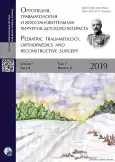卷 7, 编号 4 (2019)
- 年: 2019
- ##issue.datePublished##: 20.12.2019
- 文章: 13
- URL: https://journals.eco-vector.com/turner/issue/view/918
- DOI: https://doi.org/10.17816/PTORS74
Original Study Article
学龄前儿童先天性半椎体畸形的背侧入路手术治疗的比较分析
摘要
论证:目前,已有足够多的研究对手术干预结果进行评价,并对治疗儿童先天性脊柱畸形的各种手术
技术进行了比较分析。然而,没有共识关于手术的选择访问异常椎,考虑到操作的持续时间,术中
失血,修正的大小在干预,实现金属的长度固定的保护导致长期观测时期。
本研究的目的是针对孤立性椎体形成障碍,找出有先天性胸椎和腰椎畸形的学龄前儿童的手术治疗的
背部入路和联合入路的优缺点。
材料与方法:回顾性分析56例5岁以下胸椎、腰椎孤立半椎体背景下先天性脊柱畸形患者的治疗情况
(第1组;n = 30)或两者结合(第2组;n = 26)访问。
结果:所有患者的矢状位和前位脊柱外形均有改善。但在远期,第一组患者的腰椎畸形后凸部分从
19°例发展到8°例,而脊柱侧弯部分的矫正值保持稳定。第一组患者术中出血量较少(234 毫升,
第二组为319 毫升),手术时间较长(310和185分钟)。平均而言,与第二组相比,第一组采用了更
长的金属结构来矫正脊柱畸形。
结论:单侧半椎体联合入路的先天性脊柱畸形矫正可以通过固定少量的椎体来实现先天性弯曲的完全
矫正。然而,在长期的随访中,与背部入路相比,结果稳定。与联合手术相比,孤立的半椎体背侧通
路术中失血量较低,但孤立的背侧通路的手术干预时间较长。
 5-14
5-14


脊柱畸形手术中矫正棒的断裂 (临床资料分析及文献系统回顾)
摘要
论证:矫正棒断裂是脊柱畸形手术的特殊并发症之一。关于这题的出版材料很少,而且作者的结论往往相互矛盾。
目的分析各种原因的脊柱畸形的内矫正棒断裂的问题,考虑到这种并发症的频率和危险因素。
材料与方法:该研究包括在1996年至2018年间做过手术的3833名患者。研究入选标准的年龄为10岁
以上,病史无脊柱手术。
结果:3833位患者中有85位(2.2%)发生金属结构的植入物的骨折。特发性脊柱侧凸与先天性脊柱侧凸存在显著性差异。在85位患者中有62位发生了矫正棒断裂,因此需要反复手术干预,通过连接器恢复矫正棒的完整性或完全的替换。体重指数增加1,骨折几率增加1.07倍(p = 0.019),年龄
增加1岁,骨折几率增加1.03倍(p = 0.039)。手术治疗的腹侧期(椎间盘切除术及与自体骨的椎体间融合术)与骨折之间无统计学意义(p = 0.403)。在20岁以下的患者组中,年龄大于15岁是一个有统计学意义的预测因子(p = 0.048)。在20岁以下的患者中,体重指数与骨折风险之间没有统计学意义上的阈值。混合固定系统的并发症发生率明显低于钩式固定系统。
进行了系统地回顾关于Scopus、Medline、GoogleScholar等国际数据库中讨论的主题的文献来源,
并搜索参考文献列表中的出版物。
结论:脊柱畸形手术中各种原因导致矫正棒断裂是典型的并发症之一。在大研究组中,矫正棒断裂的频率较低。随着患者体重指数和年龄的增加,这种并发症发生的风险也会增加,尽管对于20岁以下
的一组患者来说,体重指数与骨折的几率之间没有统计学上显著的阈值。现代的椎弓根系统将内矫正棒连接到椎体结构上,可以显著降低术后内矫正棒断裂的风险。
 15-26
15-26


改型的DUNN手术治疗儿童股骨头的骺脱离的体会 (初步结果)
摘要
论证:采用不同类型的关节外矫形股骨截骨术和经典Dunn手术,恢复青少年股骨头骺松解与急性
(部分滑膜期)和重度骨骺慢性移位的空间相关性。大量的术后缺血性并发症和/或骨骺残留移位是股骨髋臼撞击的原因,也是传统手术方法改进的契机。特别是在2007年,提出了一种改良的经典Dunn手术技术,使用轻微创伤性髋关节脱位手术。
目的评价改良Dunn手术治疗儿童股骨头的骺脱离的疗效。
材料与方法:分析10例11~15岁青少年股骨头骺脱离伴严重骨骺移位患者(6男4女)的术前、术后临床及影像学资料。5例骨骺移位是慢性的,4例是慢性背景下的急性,1例是原发性急性。对于在手术时发生急性移位的关节,在松果腺板水平上观察到部分关节粘连的迹象。根据作者的技术,所有儿童都接受了改良的Dunn手术。最长手术后的随访时间为1.5年。
结果:在5个病例中取得了令人满意的结果,在10个病例中可能还会有3个病例取得令人满意的结果。有两例由于早期出现股骨头无菌性坏死的并发症,治疗效果不佳。手术治疗早期并发症的数量与
文献一致。
结论:如今,邓恩的改良手术是唯一一种并发症相对较少的手术。它提供了一个完整和准确的骨骺重新定位,因此,消除股骨髋臼撞击在上述解剖情况。改良的Dunn手术可作为青少年股骨头骺松解合并急性(部分滑膜期)和骨骺严重移位的有效干预手段。因此,我们计划继续应用它。
 27-36
27-36


儿童畸形股骨骨髓炎起源的矫正:76例患者治疗结果分析
摘要
论证:急性血源性骨髓炎在大多数情况下影响骨骼的长骨。病变多局限于下肢。血源性骨髓炎的骨科并发症在22-71.2%的儿童,并于16.2-53.7%情况导致早期残疾。
目的基于Ortho-SUV重新定位结的被动计算机导航和Ilizarov方法,对患有血源性骨髓炎的儿童股骨畸形矫正来进行回顾性的效果分析。
材料与方法:该研究对年龄为8-17岁的76例男女患者进行了检查,患着下肢长骨的血源性骨髓炎的
后果。对反映经骨骨缝术技术与Ortho-SUV医疗器械结合,并根据Ilizarov方法疗效的数据进行了对比评估。考虑到了术前后的参考线和角度值、延伸率、撑开时间、变形矫正时间、外固定指数、并发症数量和功能结果。
结果:所有儿童都接受了畸形矫正,并恢复了患下肢部分的长度。当使用重新定位结时,
与Ilizarov外固定架(30%)相比,股骨的校正精度(94.45%)更高。第一组患者获得良好功能结果的频率比第二组的多1.5倍,并满意结果的频率几乎少2倍。使用Ortho-SUV六脚器械时,
并发症出现较少。
结论:在股骨畸形矫形阶段使用Ortho-SUV医疗器械,可以提高经骨骨缝术方法的有效性。
 37-48
37-48


出生后第一周内先天性畸形足严重程度的变化
摘要
论证:先天性畸形足,或先天性马蹄内翻足畸形,是儿童最常见的肌肉骨骼系统疾病之一。大量的文章已经发表在世界文学主题的改变在治疗足部畸形的严重程度,几乎没有报道和先天性畸形足部畸形的严重程度如何改变生活的第一周没有变形的修正。
目的是分析在出生后第一周内未经治疗的先天性畸形足的严重程度的变化。
材料与方法:研究组包括28名患有先天性畸形足的新生儿(共40英尺)。畸形足的严重程度在出生后的第1天和第7天用Dimeglio和Pirani量表进行评估。
结果:在所有儿童出生第一天对新生儿进行的初步检查中,皮拉尼量表(Pirani比较表)上畸形足的严重程度为2-3分,Dimeglio量表为9-15分。因此,所有未接受治疗的患者在出生后7天内,足部马蹄内翻畸形的严重程度均显著增加(p < 0.05)。我们的研究结果显示,先天性畸形足的严重程度在出生后的第一周增加。这使得有必要在孩子出生的头几天就开始纠正严重的特发性畸形足。
结论:所有研究对象出生后第一周内先天性畸形足的严重程度均显著升高(p < 0.05; χ2表上面)。
在很大程度上,在生命的第一周,如果不治疗,马的畸形进展,然后内翻畸形,前足部复位,在较小程度上,内部旋转。
 49-56
49-56


对先天性桡偏手患儿进行撑开的连骨术延长尺骨
摘要
论证:先天性桡偏手的特点是手臂的辐射偏差、前臂缩短和上肢功能受限。尺骨缩短发生在所有类型的桡偏手。手术治疗前,尺骨较完整肢体尺骨平均缩短33.3%。
目的是根据III型、IV型先天性桡偏手患者的截骨水平,评价牵张接骨法治疗肘骨延长的效果。
材料与方法:回顾性分析1998-2018年36位先天性IV型桡偏手患者的治疗结果。平均年龄7.4 ± 3.5岁。根据尺骨切骨术水平将患者分为三组。分析了主要指标:尺骨变形角度的缩短和矫正百分率,手的径向偏差,矫正时间,获得的伸长率,固定和连骨术指数,并发症。
结果:患者观察期平均5.8年。手术前,尺骨对于正常的一肢缩短百分比33.3%,手术后为16%。
术前尺骨变形角度为20,5 ± 14,8度,术后为7,4 ± 5,6度,得到的变形角矫正矫正率为63.9%。尺骨延长了3.2 ± 1.1厘米。尺骨近端部切骨术的患者中伸长率比中、下三分之二切骨术的患者相关高
32%及18.4%。第一组的矫正期比第二、第三组相关长24.4%和28.9%。第一组固定指数比第二、
三组分别低53.6、45.7%。最常见的并发症是假关节的形成(15%)、炎症过程(10%)和前臂的继发性
畸形(7.5%)。
结论:研究表明,对于III型、IV型先天性桡偏手患者,尺骨延长的最佳切骨术区是其近段。但是,
当手的偏斜超过20时,建议在尺远端切骨术同时矫正畸形。
 57-66
57-66


帮助多发性损伤儿童的算法
摘要
论证:多发性损伤是各年龄组儿童致残和死亡的主要原因,而专科护理时机对多发性损伤的结局起着决定性作用。
目的是基于战术决策算法分析多创伤结构中肌肉骨骼系统损伤的治疗结果。
材料与方法:研究设计—前瞻性观察控制单中心。这项研究涉及130名儿童,他们被分成两组。主组患儿由多学科访视小组给予专科医疗护理,待病情稳定后转至专科中心进行骨折微创连骨术。对照组患者从危及生命的情况下被排除,建立了骨骼牵引,并在转移到专门的中心后进行手术治疗。
结果:在主要组中,疼痛消退得更早(1.7 ± 0.6 vs 3.2 ± 0.4;p < 0.05),患者在重症监护病房的住院时间及术后加护期明显缩短(1.5 ± 0.9 vs 2.4 ± 1.4;p < 0.05)。优化策略的外科治疗受伤的能减少患者的住院时间重症监护室的主组(5.6 ± 0.3 vs 6.5 ± 0.4天),在专业部门(21.5 ± 0.7 vs 25 ± 0.9天),在医院(27.5天)。
结论:摘要提出了一种帮助多发性损伤儿童的策略决策算法,该算法包括稳定病情和在创伤后数小时内进行早期低创伤手术。
 67-78
67-78


脑瘫儿童骨代谢的生物标志物
摘要
论证:全身性骨质疏松症在脑麻痹骨科疾病的发病机制中具有重要意义。我们认为,具有行走能力的脑瘫儿童具有骨代谢特征,与无神经学背景的骨科疾病患者相比,实验室参数的变化可以体现这一
特征。
目的是确定脑性瘫痪患者的骨代谢的生物标志物,以确定与无神经学背景的骨科病理学患者相比较的可能模式。
材料与方法:我们评估的浓度钙、磷、骨吸收β-crossLaps标记,骨钙素、维生素D、I型胶原蛋白c端前肽和血清碱性磷酸酶的活性50脑瘫患者从6到12岁规模水平的运动功能根据GMFCS I-III。对照组为足外翻畸形50例。
结果:脑瘫患儿碱性磷酸酶活性为170.25 ± 59.35单位/升,对照组为145.58 ± 46.29单位/升;脑瘫组I型胶原c末端前肽浓度高于对照组(分别为324.01 ± 174.10和269.68 ± 240.98)。β-crossLaps的浓度、骨钙素、钙和维生素D的主要组低于儿童扁平足没有一般神经背景。
结论:脑性瘫痪患儿骨代谢的生物标志物的变化能够独立运动,其特征是骨吸收和骨吸收过程的活性平行增加。这使我们有可能联合使用激活骨合成代谢的药物或其底物(钙、维生素D)和抑制骨吸收的药物(特别是双膦酸盐)来预防和治疗脑瘫儿童的骨质疏松症。
 79-86
79-86


Exchange of experience
青少年先天髋脱位的长期治疗结果
摘要
论据:现代文献数据的分析表明,目前还没有青少年先天髋脱位手术治疗的选择法。关于青少年中治疗该种疾病的出版物很少。小儿科矫形外科医生对18岁以下的患者进行观察,以便将来传他们给其他专科医生。青少年全髋关节置换术的问题仍然在,因为假体的使用时间有限。目前寻找通过保持自己骨骼结构来治疗青少年生该种疾病的更新方法目前还是很重要。
目的是根据作者的方法评估青少年转子间成角切骨术后治疗先天髋脱位的长期效果。
材料与方法:从1990年到2006年,在Republican Orthopedic and Traumatological Center of the Republic of Dagestan, Dagestan State Medical University外伤骨科教研医院根据作者开发的方法对37名先天髋脱位患者进行了49例手术。该种手术是以铲式骨板固定髋关节并延伸、有角度的一种截骨术。一切手术都由一位外科医生进行。所有的患者在使用Harris技术和视觉模拟量表进行手术前后通过了临床、影像学、生物力学和统计学的检验。研究结果使用Student, Pearson, Kolmogorov的系数和置信区间(Confidence Interval)进行检验。
结果:在长达10年的长期治疗中,Harris的平均评分增加到了从44.2(95% CI 38.7-47.9)到80.5 (95% CI 77.1-85.3)。10年内的观察,(术后10-15年)评分逐渐下降为72.4(95% CI 70.1-78.3)。
13.5%的病例治疗不合格的结果主要与股骨截骨术水平选择不正确、保留无补偿的下肢缩短和髋关节疼痛有关。根据青少年的年龄组来平整股骨有角度地造成的角度未发现。在手术间隔时间双侧髋关节脱位的治疗效果的区别未出现。术后10-15年的观察,对21个关节进行了全髋关节置换术(56.7%)。
结论:我们所建议青少年先天髋脱位的手术治疗方法可以改善髋关节动静态的能力,减少住院治疗
时间,并不阻止随后的全髋关节置换术。
 87-96
87-96


Clinical cases
以β-磷酸三钙颗粒充满孤立性骨囊肿后治疗复杂性局部疼痛综合征的说明书
摘要
论证:复杂性局部疼痛综合征是一种以许多临床表现为特征的疾病,首先是与各种损害及具体周围神经支配的解剖上无限的区域有关的持续性、慢性疼痛的健康状况。
临床观察:下面描13岁患者由于腓骨下三分之一孤立性骨囊肿的手术而造成的述复杂性局部疼痛综合征的治疗。诊断基于临床、实验室、放射、仪器和组织学研究方法。治疗之中采用了药物
(止痛药、抗抑郁药、抗精神病药、抗惊厥药、非阿片类中枢性镇痛药、双磷酸盐类)、冷等离子体的消融、n. suralis神经松解术、长效的传导无痛法、以骨塑材料而充满的腓骨骨髓腔的穿通、节段切除术。
讨论:复杂性局部疼痛综合征是一种缺少调查研究的疾病,是其诊断复杂性的原因。在描述的情
况下,复杂性局部疼痛综合征的发生可以与手术中创伤组织、神经纤维的损害联系起来。一些患者中有可能没有表现研究中确定的复杂性局部疼痛综合征的时期,在此情况我们也没有观察到病理过程的阶段性。腓骨硬化部分的节段切除术后 骨髓腔的闭塞,有可能减轻疼痛的严重程度,以及随后消失的复杂区域疼痛综合征的表现。
结论:提出的例子表明治疗复杂性局部疼痛综合征各的种方法的有效性。进行复杂性局部疼痛综合征的治疗应需要考虑到疼痛综合征的病因。
 97-104
97-104


脊柱畸形矫正后的肠系膜上动脉综合征
摘要
论证:肠系膜上动脉综合征(superior mesenteric artery syndrome)是罕见的病理,由上肠系膜动脉异常偏离腹主动脉引起,导致十二指肠远端被压缩在主动脉与上肠系膜动脉之间,临床表现为急性肠梗阻:上腹部疼痛、恶心、大量呕吐。在缺乏及时治疗的情况下,患者可能会出现电解质紊乱、严重的营养不足,并增加发生胃穿孔、吸入性肺炎、牛黄形成、血栓栓塞及其他危及生命的并发症而导致死亡的风险。
临床观察:在本病例中,一位17岁的女孩在治疗因术后体重减轻引起的特发性脊柱侧凸时,通过手术矫正脊柱畸形,发现了肠系膜上动脉综合征,患者的身高与体重的比值发生了急剧变化。
讨论:由于采用了一种综合的方法来治疗这种并发症,取得了显著的临床疗效。然而,尽管保守治疗的结果,患者仍有发展成各种严重程度的慢性十二指肠梗阻的风险,可能需要手术治疗。
结论:如果不及时,并不彻底的治疗肠系膜上动脉综合征会增加慢性肠梗阻的风险。这种并发症的治疗始于保守治疗。在保守治疗无效的情况下,如果病情恶化,出现危及生命的情况(出血、穿孔),则需要手术治疗。
 105-112
105-112


Review
关于桡骨头部半脱位的现代观点
摘要
论证:桡骨小头半脱位是儿童最常见的损伤,占这个年龄段儿童总数的2.6%。在39-82%的病例中,
损伤机制是肱骨牵引,但在跌倒等情况下可发生半脱位,19-51%的病例中,损伤机制尚不清楚。
目的对文献资料进行归纳、整理,对桡骨小头半脱位的患病率、病因、发病机制、诊断和治疗现状提出看法。
材料与方法:对文学资源的搜索使用了PubMed、PubMed Central、Google Scholar、CNKI-Scholar、CYBERLENINCA和eLibrary数据库。来源的样本大多限于2000-2019年。
结果:导致半脱位的直接原因是肩关节腔内的环状韧带移位及其间置,这是由于儿童肘关节的许多解剖特征所致。桡骨小头半脱位的诊断是基于病史和临床资料,而X线和超声检查是在临床图像不清楚时进行,以排除骨折。治疗的主要方法是闭合复位,有两种方法:旋后屈曲法及极度旋前法。根据现代研究,倾向于使用极度旋前法:它在重新定位尝试的次数方面更有效率,技术上更简单,而且可能不那么痛苦。有效复位后通常不需要固定,肘关节功能完全恢复。桡骨小头半脱位后,在5-46%的病
例中,会发生复发。与复发相关的因素是小于2岁的年龄。预防桡骨小头半脱位的目的是防止3岁以下儿童的肱骨被急剧牵引,并训练儿童的家长或照顾者,使其出现半脱位的症状,以便及时为儿童提
供帮助。
结论:桡骨小头半脱位发生于儿童,通常根据临床资料诊断。治疗包括闭合复位,上肢功能恢复预后良好。
 113-124
113-124


会议论文集
会议论文集
摘要
这篇文章讲明2019年10月3-4日在圣彼得堡举行关于儿童创伤学及骨科学专题的Turner Readings科学实践会议的组织、进行过程。全体会议和分组会议的主题,对当前创伤学和儿科矫形术水平的报告以及科学和临床研究的发展前景进行分析。总共听取了104份关于儿童肌肉骨骼系统损伤的诊断、
治疗和康复及其后果、先天性和获得性疾病的报告。Turner Readings会议386个参与者中有来自俄罗斯52个地区、白俄罗斯、摩尔多瓦、乌克兰、乌兹别克斯坦、爱沙尼亚、德国、瑞士和埃及的人。
 125-132
125-132











